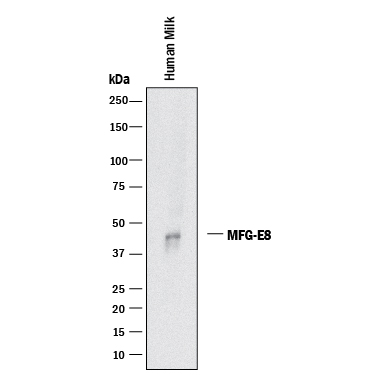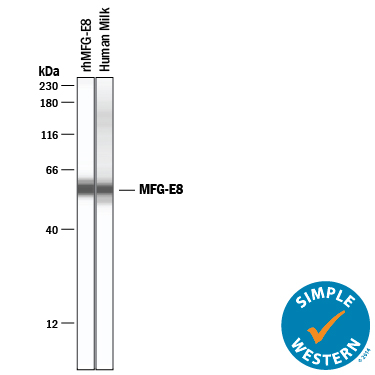Human MFG-E8 Antibody Summary
Leu24-Cys387
Accession # Q08431
Applications
Please Note: Optimal dilutions should be determined by each laboratory for each application. General Protocols are available in the Technical Information section on our website.
Scientific Data
 View Larger
View Larger
Detection of Human MFG‑E8 by Western Blot. Western blot shows lysates of human milk. PVDF membrane was probed with 1 µg/mL of Mouse Anti-Human MFG-E8 Monoclonal Antibody (Catalog # MAB2767) followed by HRP-conjugated Anti-Sheep IgG Secondary Antibody (Catalog # HAF016). A specific band was detected for MFG-E8 at approximately 45 kDa (as indicated). This experiment was conducted under reducing conditions and using Immunoblot Buffer Group 1.
 View Larger
View Larger
Detection of Human MFG‑E8 by Simple WesternTM. Simple Western lane view shows recombinant human (rh) MFG-E8, loaded at 50 ng/mL, and human milk, loaded at 0.2 mg/mL. A specific band was detected for MFG‑E8 at approximately 57-58 kDa (as indicated) using 50 µg/mL of Mouse Anti-Human MFG‑E8 Monoclonal Antibody (Catalog # MAB2767). This experiment was conducted under reducing conditions and using the 12-230 kDa separation system.
Reconstitution Calculator
Preparation and Storage
- 12 months from date of receipt, -20 to -70 °C as supplied.
- 1 month, 2 to 8 °C under sterile conditions after reconstitution.
- 6 months, -20 to -70 °C under sterile conditions after reconstitution.
Background: MFG-E8
Milk Fat Globulin Protein E8 (MFG-E8), also known as Lactadherin, MP47, breast epithelial antigen BA46, and SED1, is a 66‑75 kDa pleiotropic secreted glycoprotein that promotes mammary gland morphogenesis, angiogenesis, and tumor progression. MFG-E8 also plays an important role in tissue homeostasis and the prevention of inflammation (1). Human MGF-E8 contains one N-terminal EGF-like domain and two C‑terminal F5/8-type discoidin-like domains (2). It shares 63% and 61% aa sequence identity with comparable regions of mouse and rat MFG-E8, respectively. Shorter isoforms of human MFG-E8 may have N-terminal deletions (beginning near the end of the first discoidin-like domain), internal deletions (lacking either the EGF-like domain or the central region of the second discoidin-like domain), or C‑terminal deletions (truncated within the second discoidin-like domain) (3). A 50 aa internal proteolytic fragment of human MFG-E8 (known as Medin) is a major component of aortic medial amyloid deposits (4). MFG-E8 is released into the milk in complex with lipid-containing milk fat globules. It is also found in multiple other cell types including endothelial cells and smooth muscle cells of the vasculature, immature dendritic cells, at the acrosomal cap of testicular and epididymal sperm, and in epithelial cells of the endometrium (1). MFG-E8 binds to the Integrins alpha V beta 3 and alpha V beta 5 and potentiates the angiogenic action of VEGF through VEGF R2 (5, 6). It reduces inflammation and tissue damage in a variety of settings. MFG-E8 functions as a bridge between phosphatidylserine on apoptotic cells and Integrin alpha V beta 3 on phagocytes, leading to the clearance of apoptotic debris (7). It mediates the engulfment of apoptotic bodies in atherosclerotic plaques and prion-infected brain (8, 9) and of apoptotic B cells during germinal center reactions (10, 11). MFG-E8 also promotes the removal of excess Collagen in fibrotic lungs and the regeneration of damaged intestinal epithelia (12, 13). Its tissue-protective role impairs anti‑tumor immunity and chemotherapy-induced apoptosis (14). MFG-E8 in the breastmilk blocks rotavirus infection in nursing babies (15).
- Raymond, A. et al. (2009) J. Cell. Biochem. 106:957.
- Couto, J.R. et al. (1996) DNA Cell Biol. 15:281.
- Yamaguchi, H. et al. (2010) Eur. J. Immunol. 40:1778.
- Haggqvist, B. et al. (1999) Proc. Natl. Acad. Sci. USA 96:8669.
- Silvestre, J.-S. et al. (2005) Nat. Med. 11:499.
- Borges, E. et al. (2000) J. Biol. Chem. 275:39867.
- Hanayama, R. et al. (2002) Nature 417:182.
- Ait-Oufella, H. et al. (2007) Circulation 115:2168.
- Kranich, J. et al. (2010) J. Exp. Med. 207:2271.
- Hanayama, R. et al. (2004) Science 304:1147.
- Kranich, J. et al. (2010) J. Exp. Med. 205:1293.
- Atabai, K. et al. (2009) J. Clin. Invest. 119:3713.
- Bu, H.-F. et al. (2007) J. Clin. Invest. 117:3673.
- Jinushi, M. et al. (2009) J. Exp. Med. 206:1317.
- Kvistgaard, A.S. et al. (2004) J. Dairy Sci. 87:4088.
Product Datasheets
Citation for Human MFG-E8 Antibody
R&D Systems personnel manually curate a database that contains references using R&D Systems products. The data collected includes not only links to publications in PubMed, but also provides information about sample types, species, and experimental conditions.
1 Citation: Showing 1 - 1
-
Comparative proteomic analysis of rat aorta in a subtotal nephrectomy model.
Authors: Lin YP, Hsu ME, Chiou YY
Proteomics, 2010-07-01;10(13):2429-43.
Species: Human
Sample Types: Serum
Applications: ELISA Development
FAQs
No product specific FAQs exist for this product, however you may
View all Antibody FAQsReviews for Human MFG-E8 Antibody
There are currently no reviews for this product. Be the first to review Human MFG-E8 Antibody and earn rewards!
Have you used Human MFG-E8 Antibody?
Submit a review and receive an Amazon gift card.
$25/€18/£15/$25CAN/¥75 Yuan/¥2500 Yen for a review with an image
$10/€7/£6/$10 CAD/¥70 Yuan/¥1110 Yen for a review without an image

